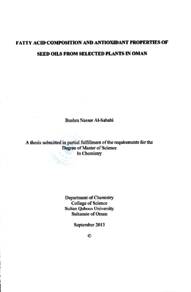وثيقة
Fatty acid composition and antioxidant properties of seed oils from selected plants in Oman
الناشر
Sultan Qaboos University
ميلادي
2013
اللغة
الأنجليزية
الموضوع
الملخص الإنجليزي
Seed oils contain fatty acids and minor components that are important to cosmetic and skin care products. Some seed oils obtained from plants which cultivated in Oman are used traditionally as skin lotion and for medical purposes. In this investigation, oils from Aeridocarpus orientalis, Citrullus colocynthis, Cucumis sativus, Moringa peregrina and Punica granatum were extracted from dry seeds and analyzed using a combination of 4,4-dimethyloxazoline derivatives and gas chromatography-electron impact mass spectrometry (GC-MS) methods. The most abundant unsaturated fatty
Is detected in the seed oils were (C18:1) (9) from A. orientalis and M. peregrine, (C18:2) (9, 12) from C. colocynthis and C. sativus, and (C18:2) (11,14) from P. granarum, respectively, Saturated fatty acids with carbon atoms in the range C16 to C22 were also found in some of the oils. The structures of the fatty acids were deduced from fragmentation profile of their 4, 4-dimethyloxazoline derivatives. The oils were also evaluated for antioxidant properties using radical scavenging assays: 2,2-diphenyl-1-pierylhydrazyl (DPPH), 2',2'-azinobis (3-ethylbenzothiazoline-6 sulfonic acid) (ABTS) assay and B-carotene bleaching method. P. granarum and M. peregrina oils with unconjugated acetylenic fatty acids demonstrated the best antioxidant capacity and could protect the skin from oxidative damage when incorporated into skin care products.
المجموعة
URL المصدر
الملخص العربي
الزيوت المستخلصة من بذور النباتات تحتوي على الأحماض الدهنية والمكونات الصغيرة المهمة لمنتجات مستحضرات التجميل والعناية بالبشرة في عمان، تستخدم بعض زيوت البذور تقليديا كدهان للبشرة وللأمراض الطبية في هذا التحقيق، تم استخراج الزيوت من البذور الحاقه لكل من الرمان (Partica grancartm) والحنظل (Citrullus colocynthis) والقفص (Acridontcarpus orientalis) واليسار (الشوع ( Moringa peregrina والخيار(Citimis scitivus) وتحليلها باستخدام مزيج من مشتقات dimethyloxoline -4ة وتأثير اللوني الإلكترون الغاز مطياف الكتلة ( GC-MS ) في الكشف عن الأحماض الدهنية في زيوت البذور ولقد اثبت الدراسة الأحماض الدهنية غير المشبعة الأكثر وفرة هي (9) (C18:1 ) في القفص و الشوع) ,M) (A , Crientalis ) Peregrinai) و (9، 12) ( C18 : 2 ) في الحنظل (C ,colocynthis ) والخيار (C182 ) ( 1411 ) ( C ) , sativus) في الرمان ( gretracarf un ,)، على التوالي. تم العثور على الأحماض الدهنية المشبعة مع كرات الكربون في مجموعة C16 إلى C22 أيضا في بعض الزيوت. وقد استخلص الهياكل من الأحماض الدهنية من الملف الشخصي تفتيت ، ومشتقاتها dimethyloxazoline-44 وجرى تقييم الزيوت أيضا لخصائص مضادة للأكسدة باستحدام ,(diphenyl - 1 - picrylhydrazyl ( DPPH- 2 , 2 و -62',2'-azinobis (3-ethylbenzothiazoline-6 sulfonic acid) (ABTS), carotene bleaching ولقد أظهر زيت الرمان والشوع قدرة أفضل كمضادات الأكسدة مع الأحماض الدهنية المقترن ، Icetylenie ويمكن أن تحمي الجلد من الضرر التأكسدي عندما تدمج مع منتجات العناية بالبشرة.
قالب العنصر
الرسائل والأطروحات الجامعية

